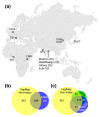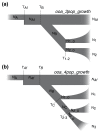Genetic diversity in India and the inference of Eurasian population expansion
- PMID: 21106085
- PMCID: PMC3156952
- DOI: 10.1186/gb-2010-11-11-r113
Genetic diversity in India and the inference of Eurasian population expansion
Abstract
Background: Genetic studies of populations from the Indian subcontinent are of great interest because of India's large population size, complex demographic history, and unique social structure. Despite recent large-scale efforts in discovering human genetic variation, India's vast reservoir of genetic diversity remains largely unexplored.
Results: To analyze an unbiased sample of genetic diversity in India and to investigate human migration history in Eurasia, we resequenced one 100-kb ENCODE region in 92 samples collected from three castes and one tribal group from the state of Andhra Pradesh in south India. Analyses of the four Indian populations, along with eight HapMap populations (692 samples), showed that 30% of all SNPs in the south Indian populations are not seen in HapMap populations. Several Indian populations, such as the Yadava, Mala/Madiga, and Irula, have nucleotide diversity levels as high as those of HapMap African populations. Using unbiased allele-frequency spectra, we investigated the expansion of human populations into Eurasia. The divergence time estimates among the major population groups suggest that Eurasian populations in this study diverged from Africans during the same time frame (approximately 90 to 110 thousand years ago). The divergence among different Eurasian populations occurred more than 40,000 years after their divergence with Africans.
Conclusions: Our results show that Indian populations harbor large amounts of genetic variation that have not been surveyed adequately by public SNP discovery efforts. Our data also support a delayed expansion hypothesis in which an ancestral Eurasian founding population remained isolated long after the out-of-Africa diaspora, before expanding throughout Eurasia.
© 2010 Xing et al.; licensee BioMed Central Ltd.
Figures





References
-
- Singh KS. People of India: An Introduction. Calcutta Anthropological Survey of India; 1992.
-
- Cavalli-Sforza LL, Menozzi P, Piazza A. The History and Geography of Human Genes. Princeton: Princeton University Press; 1994.
-
- Thapar R. Early India. Berkeley: University of California Press; 2002.
Publication types
MeSH terms
Substances
Grants and funding
LinkOut - more resources
Full Text Sources

